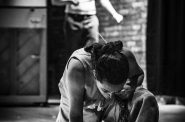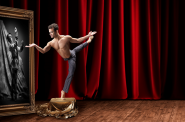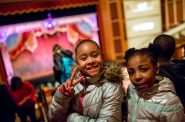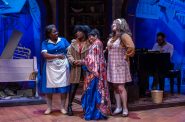Q&A with Jad Abumrad and Robert Krulwich
In this extended interview, TCD dissects all things Radiolab before "Live: In The Dark" takes the stage this Saturday at the Riverside Theater.
 When it was announced that the popular science-meets-philosophy-meets-jazz radio show known as Radiolab was going on tour and would come to a city if they asked—the internet in the Milwaukee area exploded with buzz and a booking at the Riverside Theater commenced.
When it was announced that the popular science-meets-philosophy-meets-jazz radio show known as Radiolab was going on tour and would come to a city if they asked—the internet in the Milwaukee area exploded with buzz and a booking at the Riverside Theater commenced.
Radiolab Live: In the Dark promises to be so much more than just a stage version of the radio show—a show where science and curiosity is audibly allowed to run circles around the cadent and often hilarious rhythms of show creators and hosts Jad Abumrad and Robert Krulwich—in that the concept for a live show came in direct contrast to the very small visiting national tour they did last year.
Before Saturday’s show, ThirdCoast Digest talked with Jad Abumrad and Robert Krulwich about the stage show, the origins of Radiolab, and the primal curiosity underneath it all.
Robert Krulwich: That wasn’t a really an issue. Instead we wondered if it could be transferred into something that was glorious. Jad knows how to take a laptop computer, fill it with sounds that might appear in the radio show, and then basically play them like Fats Waller on the piano. So you could—and we have—just simply go on to the stage and he plays all the parts and I just go “blah blah blah” in between. That’s easy. But this is completely different from that: it’s got dancers and comedy and live music and scoring and construction art. So Brian, this is like nothing you would even begin to suppose.
Jad Abumrad: You know, one of the things we thought to ourselves because we did a tour last year—it was sort of an itty-bitty tour—and like Robert was saying the experience of being in the audience was like watching us in the studio. In fact, we had the stage decorated like our studio. That was the conceit: “here we are, all 2,000 of us in a studio.” And that was a fun experience, but we thought “couldn’t we do something that was just for the stage?” So we teamed up with Pilobolus initially in the brain-storming phase, and they’re like this brilliant, incredibly creative modern dance company. So we had our stories, which we put to them. In these magical three days, they turned a lot of what we were doing into strange shadow puppetry, beautiful multi-bodied monsters—and suddenly it was like “oh, we could do this…”
Robert: …the sun? They literally poured the sun onto various places on the stage. So that—I can’t even explain this.
 Jad: Yeah, there are some incredibly beautiful, purely visual moments. Literally. This is not a radio show for that hour and half. So that was a fun challenge for us—Robert has done a lot of television in his past, but I’ve never done anything but radio. So this was an experiment to see if we could create an entirely new form. So thanks to Pilobolus and Demetri Martin doing comedy and Thao [Nguyen] doing music—this incredible collaboration resulted in something that it’s hard to name, it’s hard to define what this is.
Jad: Yeah, there are some incredibly beautiful, purely visual moments. Literally. This is not a radio show for that hour and half. So that was a fun challenge for us—Robert has done a lot of television in his past, but I’ve never done anything but radio. So this was an experiment to see if we could create an entirely new form. So thanks to Pilobolus and Demetri Martin doing comedy and Thao [Nguyen] doing music—this incredible collaboration resulted in something that it’s hard to name, it’s hard to define what this is.
TCD: As it relates to the subject used in the show then, was there a particular one where you thought there was something there you wanted to show people rather than just tell?
Robert: That would be right. That is the way that you’d want to tell it—I’d done a story that was all radio, it seemed to me. It was two blind guys arguing about the way to be blind. It seemed pretty radio-ey to me and Jad said, “that’s where we start.” I said, “whatya mean? There’s nothing stagey about that.”
Jad: You see, we exist in the dark. There are no pictures for what we do. So it’s like they’re in the dark, we’re in the dark. So then when a bunch of people get in their seats and the lights go down, they’re in the dark and we’re in the light—people are seeing us for the first time. But now you’ve got two blind guys in the dark arguing about which one of them is more in the dark than the other, and suddenly all of these in the darky-ness resonances sort of pile up and I thought that was a great stage show.
Robert: I don’t know why you thought that! However, from that came the conversation with Pilobolus and then since these guys were blind we would build an “eye”—because we wanted people to see that eyes have evolved. I still think they’re kind of magical; they’re very complicated. If just part of your eye is broken you can’t see with it. So if evolution is really an apt description of what has happened in the world, what would you do with a fifth of an eye or a thousandth of an eye or a millionth? You have to be good for something to endure but what would it be good for so we literally answer that question. We build an eye right in front of you with a camera and everything so you can see whatever this eye can see, and then we take you from a hagfish—not a very sophisticated see-er—all the way up to [what your eye] sees. And all of that happens between a little bit of ballet, a little bit of machine tolling, and a little bit of…I don’t know…radio is in there somewhere.
Jad: It’s kind of like radio is in the back of the bus for us on this. I remember that in the blind guy’s story, came a line…it was about two guys going into the dark. Because they both started out sighted and they both went blind in the same way, and then they fight about what’s the right way to be blind. So then we thought about what if we reversed the story and talk about people, creatures, life in general getting out of the dark. Because we all started without sight and then we all got this little ‘bit’ of an eye—this evolutionary story of the birth of the eye. So we thought we could go out of the dark; first we go into the dark and then we come out of the dark.
 Robert: Then what happened is we were talking to some astronauts. One of these astronauts was fixing something outside the MIR space station when he was blinded by the light. And the quality of what happened—it was so weird—he just goes into a strangely deep darkness while in the sunshine. The border between sunshine and darkness is so drastic that he can’t see anything in the dark. But then all hell breaks loose because he gets locked out of the space station with another guy and they can’t get in. So they’re crawling around in deep space and it becomes this space adventure. So all this kind of got folded in, and in effect we ask the audience to rescue them, and so they all have to participate. That you couldn’t do on the radio either—no, this whole thing just kind of galloped off by itself.
Robert: Then what happened is we were talking to some astronauts. One of these astronauts was fixing something outside the MIR space station when he was blinded by the light. And the quality of what happened—it was so weird—he just goes into a strangely deep darkness while in the sunshine. The border between sunshine and darkness is so drastic that he can’t see anything in the dark. But then all hell breaks loose because he gets locked out of the space station with another guy and they can’t get in. So they’re crawling around in deep space and it becomes this space adventure. So all this kind of got folded in, and in effect we ask the audience to rescue them, and so they all have to participate. That you couldn’t do on the radio either—no, this whole thing just kind of galloped off by itself.
TCD: As to the evolution of your radio show itself, there are obviously some cues there from This American Life and maybe even What the Bleep Do We Know? but where did the evolution of the show’s cadence and rhythm come in that the two of you which makes the show its own unique thing?
Jad: Well, that part of it was very mysteriously there from the very beginning. Robert and I met in 2002 or 2003, and from the very first time we met, the style of conversation you hear on the program is maybe just a slightly amplified version of what we always talk like. So that was…just there from the very minute we collided with each other. The rest of it? The evolution of the show? It’s a continuing thing. I’m not sure how to answer that.
TCD: Perhaps what I mean is that we know from articles that the two of you met, it was gangbusters—but then that first show or two—like you guys noted was not great but you were not dissuaded, that there was something there and something started to click.
Jad: Well, let me answer with this anecdote—because I feel like I get that: I remember that back then, Robert and I used to have breakfast at this particular diner. And we were talking about stuff that was interesting to us. I mentioned to him that I had done this interview with a memory scientist, and she was talking about something really cool—that when you remember something, when you call a memory to mind—you’re having to, in some sense, re-experience that experience. So every memory that you remember is being re-shaped in the act of remembering. It was a really cool idea, but the only problem was that the scientist didn’t deliver it well. She was talking in a lot of jargon, a lot of big words. Robert said, “I have an idea.”
So then we went into the studio, and at this point we hadn’t really worked together much. We went really early in the morning, because that’s the time we could get studio time, and I had these clips of tape. I played them for Robert, and he would go into some crazy riff about a rabbit in a garden like, “what does a rabbit in the garden remember about the last time it was in that garden?” I don’t know where he got this from but he starts spitting this out and it was incredibly vivid and hilarious in the only way that Robert can do. Then I think in the middle of his riff that we should hear the rabbit in the garden. So when we were done I’m going to put the sound of the rabbit and the garden in, and what he was talking about was kind of dreamy so I’m going to lay down some dreamy sounds. But then I don’t want to lose the conversational energy between us, so I’ll put that in too. But then we got this scientist, so let’s put her in too. The result was this weird amalgam of two guys talking. Every so often they would swivel their heads and this scientist would appear, and then one of the guys talking would have this thought bubble that involved a rabbit in a garden, and then we’d zoom into that garden into that thought bubble with the rabbit. It was just like some weird musical version of a surrealistic conversation.
Robert: I think the key is music. Very early on it took on this very musical logic.
TCD: Well, Jad has that in his background right? As a composer?
Robert: Right. So while he’s figuring out what do I do with Robert’s conversation, I’m thinking “wow, we’re in the middle of an improvisation here. It feels like one,” and I just begin to make the moves that a musician makes and he would just instruct me like a musician would. So almost immediately we began playing about with rhythms, silences, levels of noise—diminuendo, crescendo, and all the little punctuations that musicians can do. Then we began talking about them that way. It was very strangely…automatic.
Jad: Yeah, it was. Even that first thing we made I was thinking it was really interesting and we should try and figure that out. As a result, we made a couple of really bad hours of radio because we didn’t understand what we had made. We trying to reverse engineer it and doing it badly. But even that very first time we got together I thought that it was a very interesting, strange little blend of things and it did feel in a way improvisatory but also incredibly constructed and composed.
Robert: The key for me was my wife. My wife Tamar [Lewin] is very, very critical of what I do and works at the New York Times and has a very sort-of “New York Times-ian” attitude towards me (laughs)…and she listened to the very first thing we did, and she looked at me and her eyes got really wide and said “this is really good!” So I called Jad and I said my wife really likes it (laughs).
Jad: Actually, you were whispering because she was there. You were like “(whispering) Tamar liked it! I can’t believe it!”
Robert: But that’s when I knew that something very unusual happened.
TCD: One other aspect of your show is that it’s more than just science explained. If it was just “this is how something works,” or the How, What, Where, When—then it might just be a show like NOVA. But you guys tend to imbue “why is this happening” or “what does it all mean?”
Robert: There’s a bit of politics involved here. We wanted to model what it’s like to be curious, and being curious you get into trouble. You argue amongst yourselves about what you’ve just learned, you ask stupid questions, you poke at people who are maybe too dignified to be poked, you take a risk. We thought it would be a good idea, like you said, instead of doing the NOVA-kind that you learn what you have to know off-stage, get it down, get it right, and then put it on, that instead we would put the learning right there in front of the audience and they’d say “well, these guys aren’t really all that swift! I’m ahead of them here, behind them here, with them here,” and that gives it a certain energy that it might otherwise lack. But also does something more important. It teaches people that it’s okay to ask.
Jad: And for me, maybe, it’s more primal. It’s like, we’re alive for say, 80 or 90 years if you’re lucky. We are these little blinks and the world that we’re in is just this transient thing…it’s going to be gone in a second. And it’s like we want to understand why we’re here and what this all means before we go. So there’s this urgency to it. What the hell does it mean to be alive right now…why is the world this way and not another way. These are questions to the both of us are incredibly urgent because…
Robert: Not that we’re going to find out…
Jad: Not that we’re going to find out, but it’s like—for me it’s still a big question. And you never have a simple answer to that question. You always have ten answers. For me, it feels that the worst thing you can do is just to choose one of the ten.
TCD: But that’s what you guys do, though, is you put everything out there, but then you don’t say “okay, here’s the part where we tell you the answers to the meaning of life.” You keep things open-ended for people to keep thinking about it.
Jad: Well, that’s the whole trick of it. I think that’s what separates us from simple…science journalism. Not that it’s simple, but it is kind about walking to the edge of where science can take you and looking out at the big sea of mystery. That for me is the move.
TCD: I just have a few more minutes with you guys, so let me ask a few quick questions—Jad, what’s it like to win a MacArthur Grant?
Jad: (laughs) Uh, it was initially really trippy—I did not expect it—and it was very cloak and dagger. Okay, initially it was really amazing and a great honor, but then it was a little bit of a burden, and it’s just great. Now I have the more ordinary questions like “how am I going to use it?” I’m still figuring it out, I don’t have a clear answer yet.
TCD: Last one—with the breakneck speed of this tour, I don’t imagine you get to visit very much in each city. But is there going to be a moment where you say, “hey, let’s walk over to the bronze fonz and hit it with a tuning fork” or something?
Robert: This Midwestern part of the tour has been very rapid. Each day you’re at a different venue, so we’ve never done something like that before. So probably no.
Jad: Yeah, probably no. Actually, Robert has done a very good job of finding a way to sneak off and I’m stuck in the venue.
Robert: Yes, like in Seattle I ended up in a Quidditch game with a broom between my legs. It’s really just dodgeball with a broom between your legs, though.
Radiolab Live: In the Dark comes to the Riverside Theater on Sept. 29, with special guest stars Dave Foley (of Kids in the Hall fame), musician Thao Nguyen and dance company Pilobolus. More about the show and ticket availability can be found at the Pabst-Riverside-Turner website here.
Radiolab can be heard locally on WUWM; the one-hour episodes air Fridays at 1 p.m. and 7 p.m., and Sundays at 10 p.m., and on 90.7 WHAD at 3 p.m. on Saturdays. More information about Live: In The Dark can be found here.
Dance
-
New Riverwest Company, Production Impresses
 Feb 10th, 2020 by Brendan Fox
Feb 10th, 2020 by Brendan Fox
-
Milwaukee Ballet Show Remakes History
 Feb 10th, 2020 by Catherine Jozwik
Feb 10th, 2020 by Catherine Jozwik
-
Ballet Does Free Production of ‘Nutcracker’
 Dec 20th, 2019 by Richard Davis
Dec 20th, 2019 by Richard Davis
Theater
-
New Musical a Life and Death Comedy
![Stephanie Beschta [Mrs. McCobb] and Shayne Patrick [Mr. McCobb] in RIP – A Matter of Life and Death. Photo by Stacy Kaat (www.stacykaat.com).](https://urbanmilwaukee.com/wp-content/uploads/2024/07/WEB-6056-185x122.jpg) Jul 19th, 2024 by Dominique Paul Noth
Jul 19th, 2024 by Dominique Paul Noth
-
‘The Treasurer’ a Darkly Funny Family Play
 Apr 29th, 2024 by Dominique Paul Noth
Apr 29th, 2024 by Dominique Paul Noth
-
Rep’s Nina Simone Play a Puzzle
 Apr 23rd, 2024 by Dominique Paul Noth
Apr 23rd, 2024 by Dominique Paul Noth





















